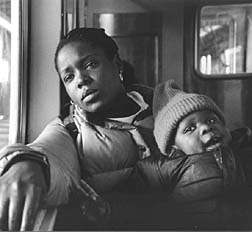

 |
In the P.O.V. special, a mother aches to keep her son. (Photo: Jennifer Dworkin.) |
Can Love Hinson escape the trap she lives in?
‘I just told them I was really, really hungry, my mother wasn’t home, and she was doing drugs.” Love Hinson, age 18, is recalling when she was 8 years old and a teacher caught her eating out of a garbage can at school. Since then, New York’s foster care system has intervened in her life, beginning a series of ordeals documented in Love and Diane, a two-hour P.O.V. special that airs next spring [April 21, 2004].
Her mother, Diane Hazzard, is the other central character in this intimate documentary about the addictions and fractured relationships of an inner-city family.
At the start of this program by first-time filmmaker Jennifer Dworkin, the mother has recovered from crack addiction and her teenage and twenty-something children, including Love, are living with her again. But Love is HIV-positive, filled with rage and hunger for the love of her own new baby, Donyaeh. She seems poised to repeat her mother’s mistakes.
Love’s future hangs on her young son, who shed the HIV virus he was born with but, due to his mother’s propensity for violent outbursts, enters the foster care system from which Love escaped. The young mother’s struggle to regain custody of Donyaeh becomes the film’s central conflict, and it’s not easily resolved. In heart-breaking scenes, Love visits the infant Donyaeh in foster care and he stares blankly at her, already confused and saddened by the failure of his most intimate human bond.
Viewers get a first-hand view of how the social service system can throw a struggling family into greater turmoil. When the household collapses and Donyaeh is placed in foster care, Diane loses custody of her son Willie. He refuses to come home, runs away from his group house and lives on the streets. Love walks the streets as well. “You have to do things to survive,” she says. Without Donyaeh living in her apartment, Diane is in jeopardy of losing her rent subsidy.
To get Donyaeh back, Love has to get her own apartment and attend regular therapy sessions. It takes a year to secure a public housing subsidy and longer for Love to show a willingness to conquer her own demons.
“That’s not how you get rid of the past—by talking about it constantly,” Love complains to her lawyer about the required therapy sessions. “I feel like I’m my mother, ’cause I’m sitting here saying the same things she would say.”
The film was shot over a decade and became a favorite of critics at last year’s New York Film Festival. It grew organically from an after-school photography workshop that Dworkin ran in a homeless shelter in the 1980s. She befriended Diane Hazzard’s nieces and nephew at the workshop, and while working on home movie with them, met Love and Diane. When she heard their stories and saw them interact, the project took on a deeper meaning.
“Their relationship is representative of generations of the family,” explains Dworkin. “If anyone is living the life that Diane did, it is Love. And Love realizes that she is fated to make the same mistakes.”
Posted Nov. 12, 2003
Current: the newspaper about public TV and radio in the United States
Current Publishing Committee, Takoma Park, Md.
(301) 270-7240